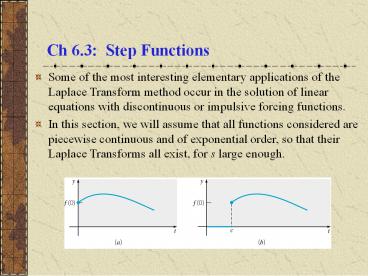Ch 6.3: Step Functions - PowerPoint PPT Presentation
Title:
Ch 6.3: Step Functions
Description:
Ch 6.3: Step Functions Some of the most interesting elementary applications of the Laplace Transform method occur in the solution of linear equations with ... – PowerPoint PPT presentation
Number of Views:232
Avg rating:3.0/5.0
Title: Ch 6.3: Step Functions
1
Ch 6.3 Step Functions
- Some of the most interesting elementary
applications of the Laplace Transform method
occur in the solution of linear equations with
discontinuous or impulsive forcing functions. - In this section, we will assume that all
functions considered are piecewise continuous and
of exponential order, so that their Laplace
Transforms all exist, for s large enough.
2
Step Function definition
- Let c ? 0. The unit step function, or Heaviside
function, is defined by - A negative step can be represented by
3
Example 1
- Sketch the graph of
- Solution Recall that uc(t) is defined by
- Thus
- and hence the graph of h(t) is a rectangular
pulse.
4
Laplace Transform of Step Function
- The Laplace Transform of uc(t) is
5
Translated Functions
- Given a function f (t) defined for t ? 0, we will
often want to consider the related function g(t)
uc(t) f (t - c) - Thus g represents a translation of f a distance c
in the positive t direction. - In the figure below, the graph of f is given on
the left, and the graph of g on the right.
6
Example 2
- Sketch the graph of
- Solution Recall that uc(t) is defined by
- Thus
- and hence the graph of g(t) is a shifted
parabola.
7
Theorem 6.3.1
- If F(s) Lf (t) exists for s gt a ? 0, and if c
gt 0, then - Conversely, if f (t) L-1F(s), then
- Thus the translation of f (t) a distance c in the
positive t direction corresponds to a
multiplication of F(s) by e-cs.
8
Theorem 6.3.1 Proof Outline
- We need to show
- Using the definition of the Laplace Transform, we
have
9
Example 3
- Find the Laplace transform of
- Solution Note that
- Thus
10
Example 4
- Find L f (t), where f is defined by
- Note that f (t) sin(t) u?/4(t) cos(t - ?/4),
and
11
Example 5
- Find L-1F(s), where
- Solution
12
Theorem 6.3.2
- If F(s) Lf (t) exists for s gt a ? 0, and if c
is a constant, then - Conversely, if f (t) L-1F(s), then
- Thus multiplication f (t) by ect results in
translating F(s) a distance c in the positive t
direction, and conversely. - Proof Outline
13
Example 4
- Find the inverse transform of
- To solve, we first complete the square
- Since
- it follows that































